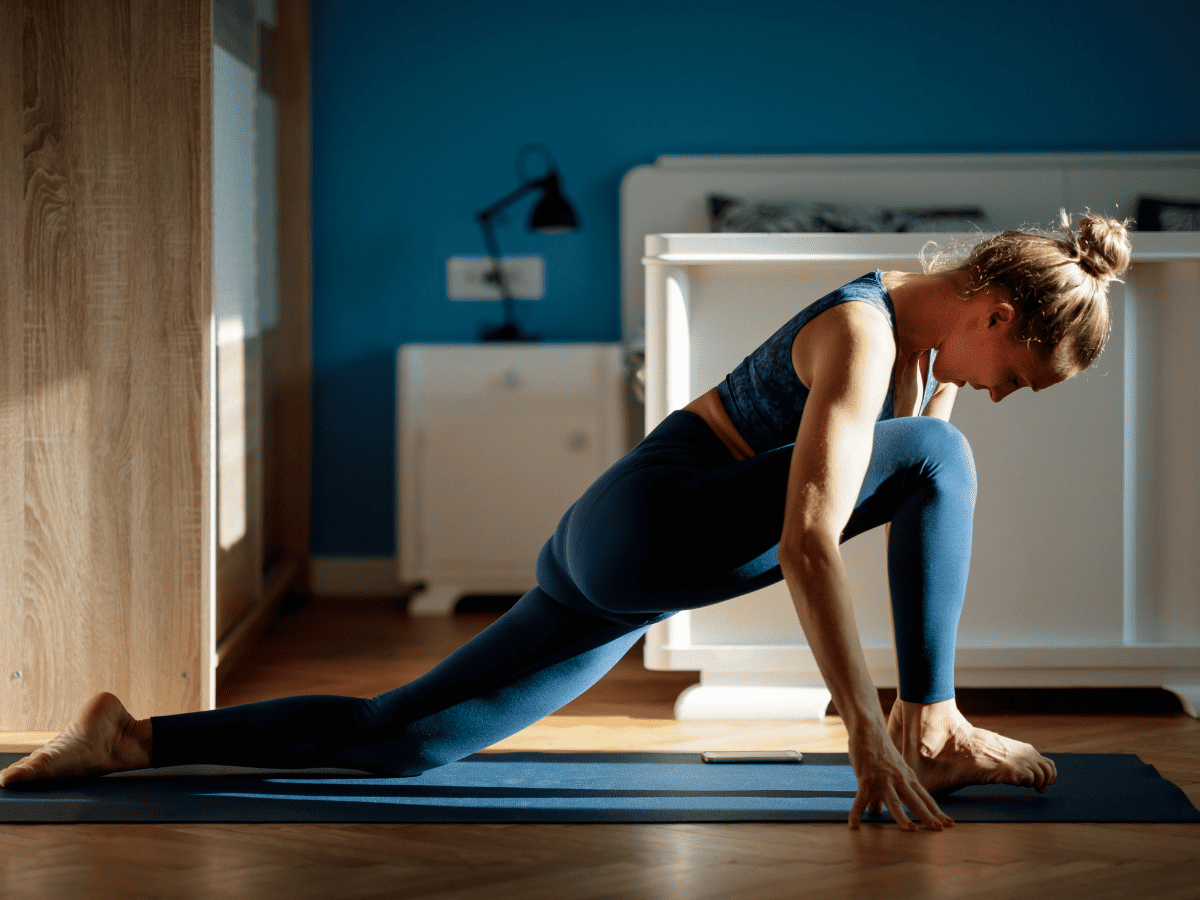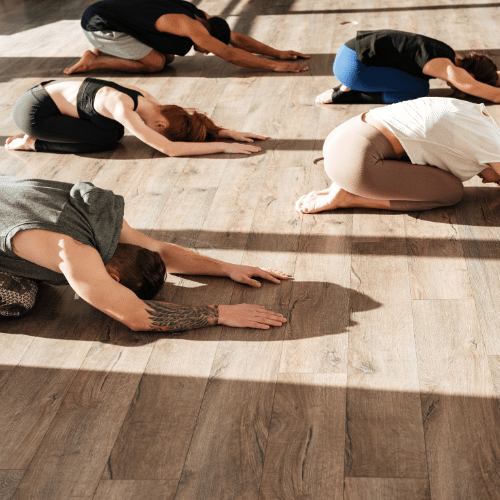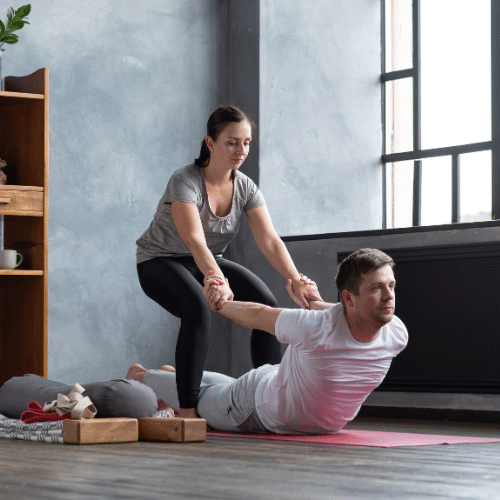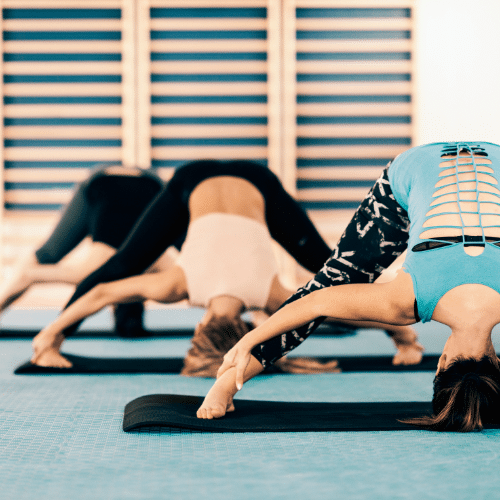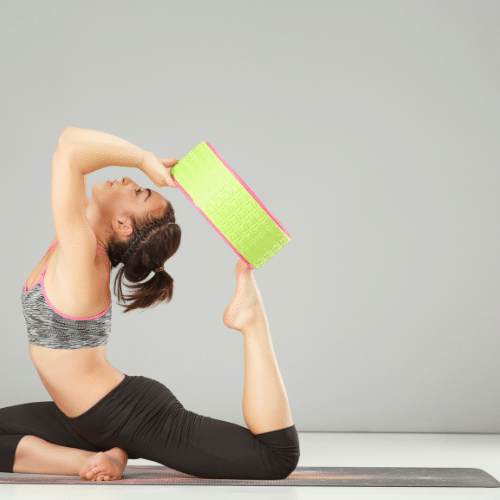Are you tired of the same old yoga poses? Looking to switch things up and challenge your body in new ways? Look no further than Lizard pose.
Lizard pose, or utthan pristhasana, is a powerful hip opener that can help relieve tension and improve hip and thigh flexibility. Plus, it’s a great way to add variety to your yoga practice.
In this article, we’ll explore the benefits of Lizard pose, how to properly execute the pose, and modifications for different levels of experience. So grab your mat, and let’s get started!
Benefits of Practicing Lizard Pose
Lizard pose, also known as Utthan Pristhasana, is a fantastic yoga posture that offers numerous benefits to the body, mind, and soul. This blog post will discuss the incredible advantages of incorporating Lizard pose into your yoga practice.
1. Strengthens Leg Muscles
Lizard pose targets the legs, particularly the hips, thighs, and quadriceps. This posture increases the strength and flexibility of these muscles, reducing the risk of injuries and improving overall physical performance.
2. Deep Hip Opener
Lizard pose is a deep hip opener that helps to increase the range of motion in the hips and groin. It stimulates the muscles and connective tissues in the hip area, promoting ease of movement and relaxation.
3. Enhances Flexibility
With regular practice, Lizard pose helps to enhance flexibility in the entire body. It improves the mobility of the joints and muscles, allowing for a broader range of motion and deeper stretches.
4. Improves Balance and Stability
Lizard pose requires physical balance and stability, making it an excellent posture for improving body awareness. It strengthens the core muscles and enhances the ability to maintain steady and stable postures.
5. Opens the Chest and Shoulders
Lizard pose involves a twist of the upper body, which aids in opening the chest and shoulders. This posture stretches the front of the shoulders and chest, helping to release tension and stress.
6. Increases Blood Flow
Lizard pose increases blood flow to the hip, groin, and pelvic areas. This promotes healthy circulation, enhances vitality, and aids in the healthy functioning of the reproductive organs.
7. Aids in Digestion
The twisting motion in Lizard pose stimulates the digestive system, aiding in the proper digestion of food and the elimination of waste from the body.
Preparing for the Pose
Before getting into lizard pose, it is essential to properly prepare your body to avoid any injuries or discomfort during the practice. Here are some steps to help you prepare for the posture:
1. Warm-Up: Begin by warming your body with a few rounds of sun salutations or other gentle stretches. This will help to awaken the muscles and joints and prepare them for deeper stretches.
2. Quad Stretch: Once you’ve had a proper warm-up, you can start with a quad stretch to prepare your legs for lizard pose. Stand in mountain pose (tadasana) and bring your right heel towards your glutes, holding onto your ankle with your right hand. Keep your knees together and lengthen your tailbone down towards the floor. Hold for a few breaths and then repeat on the other side.
3. Downward-Facing Dog: From the quad stretch, enter downward-facing dog (adho mukha svanasana) to prepare your upper body for the posture. Spread your fingers wide and press your hands firmly into the mat. Lift your hips up and back, straightening your arms and legs as much as possible. Hold for a few breaths and then release.
4. Shoulder Opener: As you come out of downward-facing dog, come down onto your hands and knees and release your chest towards the floor for a child’s pose. From here, walk your hands forward and lower your chest towards the floor, keeping your hips over your knees. Keep your arms straight and allow your chest to open towards the floor, stretching your shoulders. Hold for a few breaths and then release.
5. Preparatory Pose: Finally, come into a preparatory pose before entering into full lizard pose. Place your hands on the floor on either side of your right foot, then slowly ease your back knee onto the floor. Walk your right foot out to the right so your knee is directly above your ankle. Hold here for a few breaths, feeling the stretch in your groin and hips before continuing to full lizard pose.
By properly preparing your body for lizard pose, you can access deeper hip and leg stretches, experience enhanced flexibility and stability, and avoid potential injuries. Incorporate these preparation tips into your yoga practice, and you can perform Lizard pose easily and comfortably.
Lizard Pose Step By Step
1. Start in a high plank pose, with your wrists directly below your shoulders and your body in a straight line from head to heels. Take a few deep breaths here to center yourself.
2. Bring your right foot forward to the outside of your right hand. Keep your right knee bent at a 90-degree angle, and make sure your right ankle is directly below your right knee.
3. Slowly lower your left knee to the floor behind you, untucking your toes. Keep your left leg extended straight behind you, with the top of your left foot resting on the ground.
4. Walk both hands onto the inside of your right foot. Keep your right foot firmly planted on the ground, and make sure your right knee stays pointed forward.
5. Place a yoga block under your right thigh for extra support if needed. This can help increase your range of motion while maintaining proper alignment.
6. Take a deep inhale, then exhale as you lower your forearms to the ground. Keep your elbows directly below your shoulders, and make sure your shoulders remain relaxed away from your ears.
7. If you feel comfortable here, you can lower your hips towards the ground. Keep your lower back long and your core engaged, and continue to breathe deeply.
8. Hold the pose for 5-10 breaths, focusing on releasing tension in your hips and thigh muscles. To release the pose, gently lift your forearms to the high plank position, then step back into the downward-facing dog.
9. Repeat the pose on the other side, with your left foot forward and your right leg extended behind you.
Tips: If you have knee injuries or shoulder weakness, it is best to avoid this pose or modify it under the guidance of an instructor. Always listen to your body and never force yourself into a deeper stretch than is comfortable. And don’t forget to breathe deeply and enjoy the benefits of this deep hip opener!
Modifications and Variations of Lizard Pose
Lizard pose, also known as utthan pristhasana, is a deep hip opener that can be challenging for many practitioners. However, with some simple modifications and variations, anyone can experience the benefits of this powerful pose. In this article, we will explore some modifications and variations of Lizard Pose that can make the pose more accessible and enjoyable for all levels of yoga practitioners.
Modifications:
1. Raise the floor: If the floor is too far away, placing two yoga blocks under each hand can bring the ground up to you. This modification is beneficial for those with tight hip flexors or knee injuries.
2. Reduce the depth: If lowering your forearms to the ground feels too intense, you can always keep your hands on the floor instead. This modification allows you to stay in the pose comfortably while still receiving the benefits of the hip opener.
3. Use a strap: If you struggle to reach your foot with your arm, a strap can help you bridge the gap. Simply loop the strap around your foot and hold onto the strap with your hand. This modification can be especially useful for those with limited range of motion in the shoulder joint.
Variations:
1. Twisted Lizard Pose: If you want to add an extra challenge to Lizard Pose, try twisting your torso to the right or left, depending on which leg is in front. Place your opposite elbow on the ground and look up to the ceiling, opening your chest towards the sky. This variation provides a deep shoulder and hip opener and a detoxifying twist.
2. Side Lizard Pose: For even more of a stretch, lift your back leg off the ground and reach your arm back to grasp your foot. This variation is excellent for balancing and stretching quad and hip flexors.
3. Flying Lizard: This arm balance variation is perfect for those who want to challenge their physical balance and build arm and core strength. Begin in regular Lizard Pose, then walk your hands behind your front foot until they are directly under your shoulders. Slowly shift your weight forward, lifting your back leg off the ground and extending it out behind you. Keep your core engaged and your gaze forward as you hold for several breaths.
In conclusion, Lizard Pose can be modified and varied in many ways to meet the unique needs of different yoga practitioners. Whether you are a beginner or an advanced practitioner, with these modifications and variations, you can deepen your range of motion, build strength, and ultimately enhance your yoga practice.
If you’re interested in learning more about this pose and many others, visit us at Zuda Yoga. We are offering an introductory offer that includes 4 weeks of classes for $40. It’s a great opportunity to try out the studio.


